I love when the author says that he made it his mission to "teach people about higher eating." He taught his friends that shawarma can become a spiritual vehicle by simply pausing to say "'Isn't it great that I can live in a world world where I can have an experience like shawarma?' and then inhal[ing]."
Dining out in Korea, with all of the beauty and yummy-ness that it entails, encourages this kind of trancendence through eating. Korean food, in both it's presentation and in the way that it is eaten, is designed to make eating an experience for both the collective and the individual, with the diners' enjoyment rather than mere sustenance as it's end goal; and this is true of restaurants from the lowest end to the highest. Luckily, unlike shawarma, Korean food also happens to be generally quite healthy.
When a typical Korean meal is served it usually consists of a main dish-- usually meat along with stew-- served alongside many different banchan, or small side dishes, which are spread across the center of the table to be shared by all. Individual bowls of rice and soup are also given to each diner. The effect, with such a wide array of beautiful colors and savory flavors, is something like edible artwork. And in Korea, there is no need to worry about committing a faux pas by mixing together foods that don't go together-- the banchan, rice, and main dish can and should all be combined in any way that pleases the eater's palate.
When dining at one of Korea's many more traditional style restaurants, it is typical to take one's shoes off and sit on the floor at a low table to enjoy a meal. And while it is certainly true that dining out is a collective experience here, Koreans do not feel the same need to fill the silence during mealtimes with endless banter and small talk as we do in the US. They focus more instead on the task at hand-- the task of fully experiencing the flavors that have been set before them. I've never been one to feel uncomfortable with silence, especially in a situation where I know that it is the cultural norm, and in fact, I find it quite nice; its sort of like we are acknowledging by our silence that we are all bonded with a common purpose for that thirty minutes to an hour of transcendence via kimchi.
I can't help myself now from sharing with you just a small sampling of some of my favorite Korean foods. Hopefully, if nothing else, you can at least appreciate the beauty of these divine dishes...
 Bibimbap: Always a miguk (American) crowd-pleaser, bibimbap literally means mixed-up rice. It is served as seen in the picture in a bowl with rice on the bottom and an array of vegetables, and sometimes meat and egg, on the top. Koreans usually add hot pepper paste to spice up the taste before mixing all of the ingredients together and diving in. Apparently it is popular among young girls who are on diets in Korea, which is amazing because it certainly doesn't taste like diet food.
Bibimbap: Always a miguk (American) crowd-pleaser, bibimbap literally means mixed-up rice. It is served as seen in the picture in a bowl with rice on the bottom and an array of vegetables, and sometimes meat and egg, on the top. Koreans usually add hot pepper paste to spice up the taste before mixing all of the ingredients together and diving in. Apparently it is popular among young girls who are on diets in Korea, which is amazing because it certainly doesn't taste like diet food.(image source: dineouthere)
 Korean barbeque: Whether you are enjoying samgyeopsal (pork) or galbi (beef), Korean barbeque is always the perfect meal to share with friends. This photo gives you an idea of the typical spread of yummy fresh vegetable banchan that accompany Korean barbeque.
Korean barbeque: Whether you are enjoying samgyeopsal (pork) or galbi (beef), Korean barbeque is always the perfect meal to share with friends. This photo gives you an idea of the typical spread of yummy fresh vegetable banchan that accompany Korean barbeque. Haemul Maeuntang: Seafood dishes are quite popular on the Korean peninsula, and this spicy seafood stew is no exception. It can be served alone with just rice and banchan, or alongside another main dish, such as sashimi (raw fish). Many Koreans believe that eating warm and spicy food can balance your internal temperature on a hot day, so it isn't surprising that these kinds of stews are popular year round.
Haemul Maeuntang: Seafood dishes are quite popular on the Korean peninsula, and this spicy seafood stew is no exception. It can be served alone with just rice and banchan, or alongside another main dish, such as sashimi (raw fish). Many Koreans believe that eating warm and spicy food can balance your internal temperature on a hot day, so it isn't surprising that these kinds of stews are popular year round. Kimchi: I know that I've mentioned it before, but as the official staple of Korean cuisine I felt it deserved another shout-out. An acquired taste for many, kimchi was traditionally made in large batches and then fermented underground in preparation for the winter-- a process no longer necessary thanks to refrigeration. In Korea, anything can be flavored with kimchi: kimchi chigae (soup), kimchi ramen, kimchi spring rolls, kimchi dumplings, barbeque kimchi.. the list goes on and probably includes things that I have never heard or dreamed of.
Kimchi: I know that I've mentioned it before, but as the official staple of Korean cuisine I felt it deserved another shout-out. An acquired taste for many, kimchi was traditionally made in large batches and then fermented underground in preparation for the winter-- a process no longer necessary thanks to refrigeration. In Korea, anything can be flavored with kimchi: kimchi chigae (soup), kimchi ramen, kimchi spring rolls, kimchi dumplings, barbeque kimchi.. the list goes on and probably includes things that I have never heard or dreamed of. Gimbap: A popular fast food in Korea, gimbap wraps into a thin layer of gim (salted dried seaweed) all of the essential elements that make Korean food the wonderful experience it is. In some ways it is similar to sushi, but unlike sushi gimbap never contains raw fish and is prepared with sesame oil rather than rice vinegar.
Gimbap: A popular fast food in Korea, gimbap wraps into a thin layer of gim (salted dried seaweed) all of the essential elements that make Korean food the wonderful experience it is. In some ways it is similar to sushi, but unlike sushi gimbap never contains raw fish and is prepared with sesame oil rather than rice vinegar. Tteokbokki: Another popular snack food in Korea, tteokbokki is a favorite of both mine and my students. It consists of mainly rice cakes, smothered in a sauce made from gochujang, a spicy chili pepper paste.
Tteokbokki: Another popular snack food in Korea, tteokbokki is a favorite of both mine and my students. It consists of mainly rice cakes, smothered in a sauce made from gochujang, a spicy chili pepper paste. Nokdumuk: This dish is a made from mung bean starch. The cool jelly consistency combined with the spicy pepper and soysauce flavor of the sauce may be difficult to adjust to for some, but it has been a favorite dish of mine since I was a little girl.
Nokdumuk: This dish is a made from mung bean starch. The cool jelly consistency combined with the spicy pepper and soysauce flavor of the sauce may be difficult to adjust to for some, but it has been a favorite dish of mine since I was a little girl. Hangwa: A variety of traditional Korean confectionery treats, hangwa are generally made from grains, honey, flower, sugar and a combination of fruits and edible roots. They are never too sweet and always tasty with tea or mildly sweet rice water.
Hangwa: A variety of traditional Korean confectionery treats, hangwa are generally made from grains, honey, flower, sugar and a combination of fruits and edible roots. They are never too sweet and always tasty with tea or mildly sweet rice water. Daechu cha: This fruity tea is full of warm flavors. Now that it is getting a little cooler and feeling fall-like, I regularly make myself a cup of this tea in my office while at work; it gives me something nice to sip on while doing the mundane tasks of lesson planning or tabulating student scores.
Daechu cha: This fruity tea is full of warm flavors. Now that it is getting a little cooler and feeling fall-like, I regularly make myself a cup of this tea in my office while at work; it gives me something nice to sip on while doing the mundane tasks of lesson planning or tabulating student scores.Thinking back now, I can't recall a time where I have ever been asked to meet a Korean person for lunch or dinner without being proffered by the phrase "let's enjoy a meal together." And I can see why-- sharing a meal in Korea is a joy inducing experience indeed. :)
(Unless otherwise noted, all photos were taken from the Wikimedia Commons and are licensed under the Creative Commons Attribution ShareAlike 2.0.)

No comments:
Post a Comment